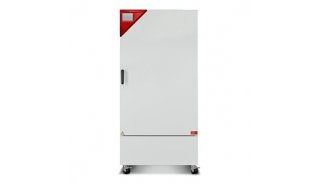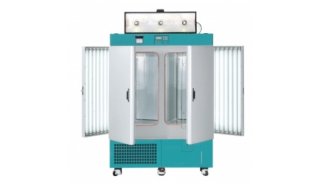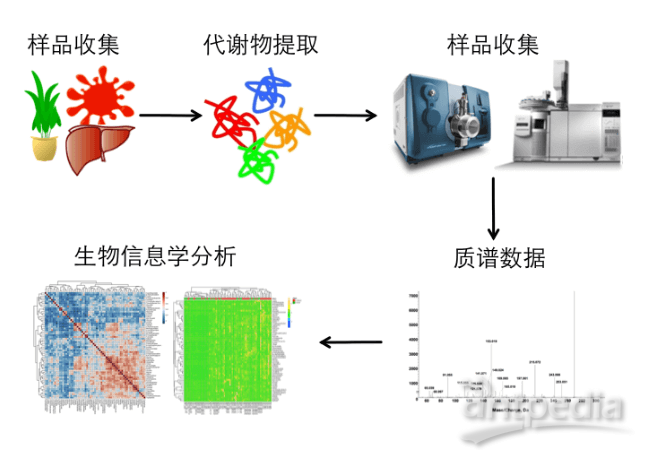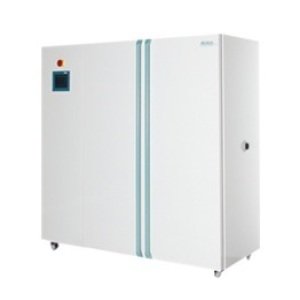NASA利用 FluorPen 研究太空植物生长适应性

John “JC” Carver, a payload integration engineer with NASA Kennedy Space Center’s Test and Operations Support Contract, uses a FluorPen to measure the chlorophyll fluorescence of Arabidopsis thaliana plants inside the growth chamber of the Advanced Plant Habitat (APH) Flight Unit No. 1. Half the plants were then harvested. Photo credit: NASA/Leif Heimbold
FluorPen 手持式叶绿素荧光仪集成了 PAM(脉冲调制)荧光测量技术及 OJIP 快速荧光 动力学测量技术等,是目前世界上便携性最强、集成度最高、功能最全面、性价比最高的 叶绿素荧光测量仪器!
体积最小,仅手机大小;
种类最全:有固定叶夹式、分离叶夹式、探头式及适用于野外长期监测的 Monitoring FluorPen,还有适于藻类测量监测的 AquaPen 等。
功能最全:内置光合有效辐射、即时叶绿素荧光、光量子产量、Kautsky 诱导效应、 2 套荧光淬灭、3 套光响应曲线及 OJIP-test 等共 10 种测量程序协议(Protocols)
参数最多:测量参数达 60 余个,其中 OJIP-test 在 1 秒时间内测量记录近 500 个
叶绿素荧光数据并通过软件即使计算出 26 个叶绿素荧光参数;
时空信息:可选配即插式 GPS(最新版本内置 GPS),输出带时间戳和经纬度的“三 维”数据
FluorPen 可以应用于生长箱(气候室)、实验室、野外及各种极端条件下的植物(包括 藻类等低等植物)生理生态学研究测量,成为目前最方便、最流行的叶绿素荧光测量仪器。
科学家在北极地区应用 FluorPen 监测研究地衣类植物对气候变化的响应
近期部分参考文献:
AJIGBOYE O. O.,
LU CH., MURCHIE E. H., ET AL. (2017). Altered gene expression by
sedaxane increases PSII efficiency, photosynthesis and growth and
improves tolerance to drought in wheat seedlings. Pesticide Biochemistry
and Physiology. Volume 137. Pages 49-61. DOI:
10.1016/j.pestbp.2016.09.008
CHEKANOV К., SCHASTNAYA E., SOLOVCHENKO A., ET AL. (2017). Effects of CO2 enrichment onprimary photochemistry, growth and astaxanthin accumulation in the chlorophyte Haematococcus pluvialis. Journal of Photochemistry and Photobiology B: Biology. Volume 171. DOI 10.1016/j.jphotobiol.2017.04.028
DUARTE B., PEDRO S., MARQUES J. C., ET AL. (2017). Zostera noltii development probing using chlorophyll a transient analysis (JIP-test) under field conditions: Integrating physiological insights into a photochemical stress index. Ecological Indicators. Volume 76. DOI: 10.1016/j.ecolind.2017.01.023
HERNÁNDEZ-CLEMENTE R., NORTH P.R.J., HORNERO A., ET AL. (2017). Assessing the effects offorest health on sun-induced chlorophyll fluorescence using the FluorFLIGHT 3-D radiative transfer model to account for forest structure, Remote Sensing of Environment,. Volume 193. Pages165-179. DOI: 10.1016/j.rse.2017.02.012
LEE M. W., HUFFAKER A., CRIPPEN D., ET AL. (2017). Plant Elicitor Peptides Promote Plant Defenses against Nematodes in Soybean. Molecular Plant Pathology. DOI: 10.1111/mpp.12570
MARTEL A. B. AND QADERI M. M. (2017). Light quality and quantity regulate aerobic methane emissions from plants. Physiol Plantarum. Volume 159. DOI:10.1111/ppl.12514
PARADISO R., ARENA C., DE MICCO V., ET AL. (2017). Changes in Leaf Anatomical Traits Enhanced Photosynthetic Activity of Soybean Grown in Hydroponics with Plant Growth-Promoting Microorganisms. Frontiers in Plant Science. Volume 8. DOI: 10.3389/fpls.2017.00674
PTUSHENKO V.V., PTUSHENKO O.S., SAMOILOVA O.P., ET AL. (2017). The analysis ofphotoprotection and apparent non-photochemical quenching of chlorophyll fluorescence in Tradescantia leaves based on the rate of irradiance-induced changes in optical transparence. Biochemistry (Moscow).Volume 82. DOI: 10.1134/S0006297917010072
PUGLIELLI G., REDONDO-GÓMEZ S., GRATANI L., ET AL. (2017). Highlighting the differential role of leaf paraheliotropism in two Mediterranean Cistus species under drought stress and well-watered onditions. Journal of Plant Physiology. Volume 213. DOI: 10.1016/j.jplph.2017.02.015
PUSHKAREVA E., KVÍDEROVÁ J., ŠIMEK M.,ET AL. (2017). Nitrogen fixation and diurnal changes of photosynthetic activity in Arctic soil crusts at different development stage. European Journal of Soil Biology. Volume 79. Pages 21-30. DOI: 10.1016/j.ejsobi.2017.02.002
SELVARAJ, M.G., ISHIZAKI, T., VALENCIA, M., ET AL. (2017). Overexpression of an Arabidopsis thaliana galactinol synthase gene improves drought tolerance in transgenic rice and increased grain yield in the field. Plant Biotechnol. J. DOI: 10.1111/pbi.12731
SINGH M., KUSHWAHA K. B., SINGH, S., ET AL. (2017). Sulphur alters chromium (VI) toxicity in Solanum melongena seedlings: Role of sulphur assimilation and sulphur-containing antioxidants. Plant Physiology and Biochemistry. Volume 112. DOI: 10.1016/j.plaphy.2016.12.024
SINGH S. & PRASAD S. M. (2017) Effects of 28-homobrassinoloid on key physiological attributes of Solanum lycopersicum seedlings under cadmium stress: Photosynthesis and nitrogen metabolism. Plant Growth Regul J. Volume 82. DOI:10.1007/s10725-017-0248-5
TRIPATHI D. K., MISHRA R. K., SINGH S., ET AL. (2017). Nitric Oxide Ameliorates Zinc Oxide Nanoparticles Phytotoxicity in Wheat Seedlings: Implication of the Ascorbate–Glutathione Cycle. Frontiers in Plant Science. Volume 8. DOI: 10.3389/fpls.2017.00001
TRIPATHI D. K., SINGH S., SINGH S., ET AL. (2017). Nitric oxide alleviates silver nanoparticles (AgNps)-induced phytotoxicity in Pisum sativum seedlings. Plant Physiology and Biochemistry. Volume 110. DOI: 10.1016/j.plaphy.2016.06.015
TRIPATHI D. K., SINGH S., SINGH V. P., ET AL. (2017). Silicon nanoparticles more effectively alleviated UV-B stress than silicon in wheat (Triticum aestivum) seedlings, Plant Physiology and Biochemistry. Volume 110. DOI: 10.1016/j.plaphy.2016.06.026
ZORIN B., PAL-NATH D., LUKYANOV A.,ET AL. (2017). Arachidonic acid is important for efficient use of light by the microalga lobosphaera incisa under chilling stress. Biochimica et Biophysica Acta- Molecular and Cell Biology of Lipids. DOI 10.1016/j.bbalip.2017.04.008
AHMED S., ARIYARATNE M., PATEL J., ET AL. (2016). Altered expression of polyamine transporters reveals a role for spermidine in the timing of flowering and other developmental response pathways., Plant Science. DOI: 10.1016/j.plantsci.2016.12.002
AJIGBOYE O. O., BOUSQUET L., MURCHIE E. H. ET AL.(2016). Chlorophyll fluorescence parameters allow the rapid detection and differentiation of plant responses in three different wheat pathosystems. Functional Plant Biology. Volume 43. Pages 356–369. DOI: 10.1071/FP15280
ATHAR H. R., AMBREEN S., JAVED M. ET AL. (2016). Influence of sub-lethal crude oil concentration on growth, water relations and photosynthetic capacity of maize (Zea mays L.) plants.Environmental Science and Pollution Research. Volume 23, Issue 18, Pages 18320–18331. DOI: 10.1007/s11356-016-6976-7
BARÁNYIOVÁ I. AND KLEM K. (2016). Effect of application of growth regulators on the physiological and yield parameters of winter wheat under water deficit. Plant, Soil and Environment. Volume 62, No. 3, Pages 114–120. DOI: 10.17221/778/2015-PSE
CHEKANOV K., LUKYANOV A., BOUSSIBA S. ET AL. (2016). Modulation of photosynthetic activity and photoprotection in Haematococcus pluvialis cells during their conversion into haematocysts and back. Photosynthesis Research. Volume 128, Issue 3, Pages 313–323. DOI:10.1007/s11120-016-0246-x
CHOI H. G., MOON B. Y. AND KANG N. J. (2016). Correlation between Strawberry (Fragaria ananassa Duch.) Productivity and Photosynthesis-Related Parameters under Various Growth Conditions. Frontiers in Plant Science. Volume 7. DOI: 10.3389/fpls.2016.01607
DUARTE B., CABRITA M. T., GAMEIRO C. ET AL. (2016). Disentangling the photochemical salinity tolerance in Aster tripolium L. : Connecting biophysical traits with changes in the fatty acid composition. Plant biology. DOI: 10.1111/plb.12517
ESTEBAN R., ROYO B., URARTE E. ET AL. (2016). Both Free Indole-3-Acetic Acid and Photosynthetic Performance are Important Players in the Response of Medicago truncatula to Urea and Ammonium Nutrition Under Axenic Conditions. Frontiers in Plant Science. Volume 7. DOI: 10.3389/fpls.2016.00140
FROSI G., BARROS V. A., OLIVEIRA M. T., ET AL. (2016). Symbiosis with AMF and leaf Pi supply increases water deficit tolerance of woody species from seasonal dry tropical forest. Journal of Plant Physiology. Volume 207. DOI: 10.1016/j.jplph.2016.11.002
HIDRI R., BAREA J.M., MAHMOUD O. MB. ET AL. (2016). Impact of microbial inoculation on biomass accumulation by Sulla carnosa provenances, and in regulating nutrition, physiological and antioxidant activities of this species under non-saline and saline conditions. Journal of Plant Physiology. Volume 201, Pages 28–41. DOI: 10.1016/j.jplph.2016.06.013
KANECHI M., MAEKAWA A., NISHIDA Y. AND MIYASHITA, E. (2016). Effects of pulsed lighting based light-emitting diodes on the growth and photosynthesis of lettuce leaves. Acta Hortic. Volume 1134. DOI: 10.17660/ActaHortic.2016.1134.28
LV DW., ZHU GR., ZHU D. ET AL. (2016). Proteomic and phosphoproteomic analysis reveals the response and defense mechanism in leaves of diploid wheat T. monococcum under salt stress and recovery. Journal of Proteomics. Volume 143, Pages 93–105. DOI: 10.1016/j.jprot.2016.04.013
LÓPEZ-LÓPEZ M., CALDERÓN R., GONZÁLEZ-DUGO V., ET L . (2016). Early Detection andQuantification of Almond Red Leaf Blotch Using High-Resolution Hyperspectral and Thermal Imagery. Remote Sens. Volume 8. DOI:10.3390/rs8040276
MALIK V.M., LOBO J.M., STEWART C. ET AL. (2016). Growth irradiance affects ureide accumulation and tolerance to photoinhibition in Eutrema salsugineum (Thellungiella salsuginea).Photosynthetica. Volume 54. DOI:10.1007/s11099-015-0164-8
MARTEL A. B. AND QADERI M. M. (2016). Light quality and quantity regulate aerobic methane emissions from plants. Physiol Plantarum. DOI: 10.1111/ppl.12514
MISHRA R. K. KUMAR J., SRIVASTAVA P. K., ET AL. (2016). PSII photochemistry, oxidative damage and anti-oxidative enzymes in arsenate-stressed Oryza sativa L. seedlings. Volume 33. DOI: 10.1080/02757540.2016.1265516
NAUŠ J., ŠMECKO S. AND ŠPUNDOVÁ M. (2016). Chloroplast avoidance movement as a sensitive indicator of relative water content during leaf desiccation in the dark. Photosynthesis Research. Volume 129, Issue 2, Pages 217–225. DOI: 10.1007/s11120-016-0291-5
OYIGA B. C., SHARMA R. C., SHEN J., (2016). Identification and Characterization of Salt Tolerance of Wheat Germplasm Using a Multivariable Screening Approach. J Agro Crop Sci, 202: 472–485. DOI: 10.1111/jac.12178
PANEQUE M, DE LA ROSA J. M., FRANCO-NAVARRO J. D., ET AL. (2016). Effect of biocharamendment on morphology, productivity and water relations of sunflower plants under non-irrigation conditions, CATENA, Volume 147. DOI: 10.1016/j.catena.2016.07.037
PEDRANZANI H., RODRÍGUEZ-RIVERA M., GUTIÉRREZ M. ET AL. (2016). Arbuscular mycorrhizalsymbiosis regulates physiology and performance of Digitaria eriantha plants subjected to abiotic stresses by modulating antioxidant and jasmonate levels. Mycorrhiza. Volume 26, Issue 2, Pages 141–152. DOI: 10.1007/s00572-015-0653-4
PTUSHENKO V. V. AND SOLOVCHENKO A. E. (2016). Tolerance of the photosynthetic apparatus to acidification of the growth medium as a possible determinant of CO2-tolerance of the symbiotic microalga DESMODESMUS sp. IPPAS-2014. Biochemistry Moscow. Volume 81.DOI:10.1134/S0006297916120142
RUIZ-LOZANO J. M., AROCA R., ZAMARREÑO Á. M. ET AL. (2016. Arbuscular mycorrhizal symbiosis induces strigolactone biosynthesis under drought and improves drought tolerance in lettuce and tomato. Plant, Cell and Environment. Volume 39, Pages 441–452. DOI: 10.1111/pce.12631
WATANABE T., ORIKASA T, SHONO H. ET AL. (2016). The influence of inhibit avoid water defect responses by heat pretreatment on hot air drying rate of spinach, Journal of Food Engineering, Volume 168. DOI: 10.1016/j.jfoodeng.2015.07.014
SOLOVCHENKO A.,GORELOVA O., SELYAKH I., ET AL. (2016). Nitrogen availability modulates CO2 tolerance in a symbiotic chlorophyte. Algal Research. 2016. 16. 177-188. DOI 10.1016/j.algal.2016.03.002
TIMM C. M., PELLETIER D. A., JAWDY S. S. ET AL. (2016.) Two Poplar-Associated Bacterial Isolates Induce Additive Favorable Responses in a Constructed Plant-Microbiome System. Frontiers in Plant Science. Volume 7. DOI: 10.3389/fpls.2016.00497
WATANABE T., ORIKASA T, SHONO H. ET AL. (2016). The influence of inhibit avoid water defect responses by heat pretreatment on hot air drying rate of spinach, Journal of Food Engineering, Volume 168. DOI: 10.1016/j.jfoodeng.2015.07.014
WEI J., YANG H., CAO H. AND TAN T. (2016) Using polyaspartic acid hydro-gel as water retaining agent and its effect on plants under drought stress. Saudi Journal of Biological Sciences. Volume 23, Pages 654–659. DOI: 10.1016/j.sjbs.2015.08.016
ZANDALINAS S. I., RIVERO R. M., MARTÍNEZ V., ET AL. (2016). Tolerance of citrus plants to the combination of high temperatures and drought is associated to the increase in transpiration modulated by a reduction in abscisic acid levels. BMC Plant BiologyBMC.Volume 16. DOI: 10.1186/s12870-016-0791-7
ZARCO-TEJADA P.J., GONZÁLEZ-DUGO M.V. AND FERERES E. (2016). Seasonal stability ofchlorophyll fluorescence quantified from airborne hyperspectral imagery as an indicator of net photosynthesis in the context of precision agriculture. Remote Sensing of Environment. Volume 179. Pages 89–103. DOI: 10.1016/j.rse.2016.03.024
ANDERSON L. G., DUNN A. M. , ROSEWARNE P. J. AND STEBBING P. D. (2015). Invaders in hot water:a simple decontamination method to prevent the accidental spread of aquatic invasive non-native species. Biological Invasions. Volume 17, Issue 8, Pages 2287–2297. DOI:10.1007/s10530-015-0875-6
ARMADA E., BAREA J.M., CASTILLO P. ET AL. (2015). Characterization and management of autochthonous bacterial strains from semiarid soils of Spain and their interactions with fermented agrowastes to improve drought tolerance in native shrub species. Applied Soil Ecology. Volume 96, Pages 306–318. DOI: 10.1016/j.apsoil.2015.08.008
ARMADA E., AZCÓN R., LÓPEZ-CASTILLO O. M. ET AL. (2015). Autochthonous arbuscular mycorrhizal fungi and Bacillus thuringiensis from a degraded Mediterranean area can be used to improve physiological traits and performance of a plant of agronomic interest under drought conditions. Plant Physiology and Biochemistry. Volume 90, Pages 64–74. DOI: 10.1016/j.plaphy.2015.03.004
BARTÁK M., TRNKOVÁ K., HANSEN E. S. ET AL. (2015). Effect of dehydration on spectral reflectance and photosynthetic efficiency in Umbilicaria arctica and U. hyperborean. Biologia Plantarum. Volume 59, Issue 2, Pages 357–365. DOI: 10.1007/s10535-015-0506-1
BÁRZANA G., AROCA R. AND RUIZ-LOZANO J. M. (2015). Localized and non-localized effects of arbuscular mycorrhizal symbiosis on accumulation of osmolytes and aquaporins and on antioxidant systems in maize plants subjected to total or partial root drying. Plant, Cell and Environment.Volume 38, Issue 8, Pages 1613–1627. DOI: 10.1111/pce.12507
DUARTE B., GOESSLING J.W., MARQUES J.C. AND CAÇADOR I. (2015)Ecophysiological constraints of Aster tripolium under extreme thermal events impacts: Merging biophysical, biochemical and genetic insights. Plant Physiology and Biochemistry. Volume 97, Pages 217–228. DOI: 10.1016/j.plaphy.2015.10.015
KHALID A., ATHAR H., ZAFAR Z. U. ET AL. (2015). Photosynthetic capacity of canola (Brassica napus L.) plants as affected by glycinebetaine under salt stress. Journal of Applied Botany and Food Quality. Volume 88, Pages 78- 86. DOI:10.5073/JABFQ.2015.088.011
JIMÉNEZ J. D. L. C., CARDOSO J. A., DOMINGUEZ M. ET AL. (2015). Morpho-anatomical traits of root and non-enzymatic antioxidant system of leaf tissue contribute to waterlogging tolerance in Brachiaria grasses. Grassland Science. Volume 61, Pages 243–252. DOI:10.1111/grs.12095
MARQUEZ-GARCIA B., SHAW D., COOPER J. W. ET AL. (2015). Redox markers for drought-induced nodule senescence, a process occurring after drought-induced senescence of the lowest leaves in soybean (Glycine max). Annals of Botany. Volume 116, Pages 497–510. DOI: 10.1093/aob/mcv030
DYAKOV M.Y., INSAROVA I.D., KHARABADZE, D.E., PTUSHENKO V. V., and SHTAER, O. V. (2015).Influence of extreme ambient temperatures and anaerobic conditions on Peltigera aphthosa (L.) Willd. viability. Life sciences in space research 7: pp. 66-72, doi:10.1016/j.lssr.2015.10.002
KOSOVÁ K., VÍTÁMVÁS P., HLAVÁČKOVÁ I. ET AL. (2015). Responses of two barley cultivars differing in their salt tolerance to moderate and high salinities and subsequent recovery. Biologia Plantarum. Volume 59, Pages 106-114. DOI: 10.1007/s10535-014-0465-y
SOLOVCHENKO A., GORELOVA O., SELYAKH I., ET AL. (2015). A novel CO2-tolerant symbioticDesmodesmus (Chlorophyceae, Desmodesmaceae): acclimation to and performance at a high carbon dioxide level. Algal Research. Volume 11. DOI 10.1016/j.algal.2015.04.011
PTUSHENKO V. V., AVERCHEVA O. V., BASSARSKAYA E. M., BERKOVICH Y. A., EROKHIN, A. N.,SMOLYANINA S. O., and ZHIGALOVA, T. V. (2015). Possible reasons of a decline in growth of Chinese cabbage under a combined narrowband red and blue light in comparison with illumination byhigh-pressure sodium lamp. Scientia Horticulturae, 194: pp. 267-277, doi:10.1016/j.scienta.2015.08.021
OREKHOV D.I., V., YAKOVLEVA S. N., GORYACHEV F. F., PROTOPOPOV F.F., and ALEKSEEV, A.A.(2015). The use of parameters of Chlorophyll a fluorescence induction to evaluate the state of plants under anthropogenic load. Biophysics, 2015, Vol. 60, No. 2, pp. 263–268, doi: 10.1134/S0006350915020128
FESENKO I. A., ARAPIDI G. P., SKRIPNIKOV A. Y., ET AL. (2015). Specific pools of endogenous peptides are present in gametophore, protonema, and protoplast cells of the moss Physcomitrella patens. Pesticide Biochemistry and Physiology. Volume 15, Pages 1-16. DOI10.1186/s12870-015-0468-7
HUMPLÍK J. F., LAZÁR D., FÜRST T. ET AL. (2015). Automated integrative high-throughput phenotyping of plant shoots: a case study of the cold-tolerance of pea (Pisum sativumL.). Plant Methods. Volume 11, Pages 1-11. DOI 10.1186/s13007-015-0063-9
TRIPATHI D. K., SINGH V. P., PRASAD S. M. ET AL. (2015). Silicon-mediated alleviation of Cr(VI) toxicity in wheat seedlings as evidenced by chlorophyll florescence, laser induced breakdown spectroscopy and anatomical changes. Ecotoxicology and Environmental Safety, Volume 113, Pages 133-144. DOI:10.1016/j.ecoenv.2014.09.029
WU X., TANG Y., LI C. ET AL. (2015.) Chlorophyll Fluorescence and Yield Responses of Winter Wheat to Waterlogging at Different Growth Stages. Plant Production Science. Volume 18, Issue 3. DOI: 10.1626/pps.18.284
ZMIENKO A., GORALSKI M., SAMELAK-CZAJKA A. ET AL. (2015). Time course transcriptional profiling of senescing barley leaves. Genomics Data. Volume 4, Pages 78–81. DOI: 10.1016/j.gdata.2015.03.0063





















